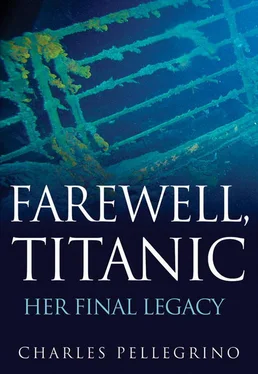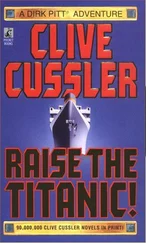Rowe looked forward and saw what he at first mistook for a windjammer that had crossed the Titanic’ s path with all of its sails set, but as it came into the glare of the “whiskered” lights, he realized that it was an iceberg. Like Silverthorne, he saw a wall of ice that appeared to be rising along the ship’s side now that great slivers of mass had fallen away. Far in front of Silverthorne and Rowe, and more than fifteen seconds earlier, witnesses near the bridge saw a berg that did not quite reach the boat deck. Rowe witnessed an iceberg that had already avalanched entire cliffs into the sea; it was rising about twenty feet above the boat deck, a hundred feet above the waterline.
The engines were trying to bring the propellers to a stop by then, but the effort seemed to make no difference, and the iceberg continued moving away from the back of the ship until at last it ceased to reflect anything from the Titanic ’s lamps and became a receding silhouette, lost among the stars.
• • •
The immediate aftermath was deceptively peaceful, with neither the iceberg nor the ship appearing to have suffered greatly. Despite a combined release of energy that was capable of lifting the mass of fourteen Washington Monuments in a second, the rate at which the Titanic ’s breached compartments began to flood would reveal to naval architect Edward Wilding that the total aggregate of punctures, rips, and parted seams added up to twelve square feet of openings to the sea—a surface area equal to approximately two sidewalk squares.
In many places (such as near the fire-damaged bulkhead, where Fred Barrett had been standing), the centers of the hull plates rattled and bent like parchment but did not break, except perhaps where blocks of ice had crumbled loose and gotten slammed between the iceberg and the hull, becoming focused impacts that sometimes allowed relatively soft ice to punch holes through steel plates already being deformed at points of severe ice ramming, in much the same manner that twenty-first-century antitank weapons would routinely pierce armor plate with relatively soft copper in focused bursts. The single hole in Barrett’s empty coal bunker was consistent with this sort of damage.
The Titanic took the shock like a series of gunshots, stabs, and rivet-popping punches—with the impacted plates rippling somewhat like dolphin skin and occasionally becoming slightly concave, while the main body of the ship remained mostly on course. Outside the impact zones, the passengers and the crew had felt little apparent resisting shock, as though the Titanic were merely a human hand striking a glancing blow against a sharp instrument.
Crushed and half sunk on the bed of the Atlantic, the Titanic ’s entire stern section and most of its debris would eventually be found at latitude 41 degrees 43 minutes north and longitude 49 degrees 56 minutes west (just over 960 miles northeast of Manhattan). Only twelve hours before the convergence of the iceberg and the Titanic , a Marconi operator aboard SS Mesaba had radioed that ice was drifting southward into this same path:
Latitude 41 deg. 50 min. north—Longitude 49 deg. 15 min. west, passed a quantity of bergs, some very large. Also, a field of pack ice about five miles long, with numerous bergs intermixed…. Had to steer about twenty miles south to clear it. The ice seemed to be one solid wall—[of bergs] at least sixteen feet high, as far as could be seen. In Latitude 41 deg. 35 min. north, Longitude 50 deg. 30 [min.] west, we came to the end [of the ice field], and we were again able to steer to the westward [toward the United States].
The airwaves were buzzing with such news. The steamer La Bretange reported, “Latitude 41 deg. 39 min. and Longitude 49 deg. 21 min. [through] 50 deg. 21 min., steamed through an ice field with numerous icebergs for four hours—7:30 to 11:38 a.m.” At 11:52, another ship, the Baltic , reaffirmed what lay in the path of the Titanic ’s final resting place, warning, “Icebergs and large quantity of Field Ice today at Lat. 41.51n Longitude 49.52w.” The Baltic’ s Marconi operator added that the German oil tank steamer Deutschland —also along the Titanic ’s path at latitude 40 degrees 42 minutes north—was no longer under control, it was low on coal, and it was calling out to other steamers.
With the wisdom of perfect hindsight, no one later believed that these clear warnings of danger ahead could have been responded to with anything but increased vigilance.
Down in third class, close to the waterline and approximately forty minutes before impact, Neshan Krekorian became the first and only known survivor positioned low enough to witness the deadly fleet edge-on, along the horizon line. Located in quarters only two decks above the ship’s waterline, he had gone to sleep in a room where heating problems were correctable only after his bunkmates opened both portholes. By 11 p.m., the temperature in the room had shifted from unbearably hot to unbearably cold.
When Krekorian arose from his bed to close the portholes (according to his report to the Hamilton, Ontario, Spectator , dated April 25, 1912), he saw distant dark shapes moving against the starry horizon. “I noticed many icebergs in the water of a comparatively large size,” he said. “I thought little about them, however, despite the fact that they were the first I had ever seen, as they were hardly perceptible from the distance they were from the boat.”
Several decks higher, the icebergs would not likely have been perceptible on the horizon at all. From where Krekorian stood, about twenty feet above the surface of the Atlantic, an iceberg standing seventy feet tall, half a mile away, would be barely discernible as a dark nub protruding above the horizon, moving against the backdrop of stars. Viewed from an angle almost sixty feet above Krekorian, on the Titanic ’s bridge, an observer would be looking down upon that same iceberg—an invisible black shape lower than the horizon, silhouetted against black seas. Thirty feet above the bridge, in the crow’s nest, where the Titanic ’s two lookouts stood, a berg reaching even as tall as the bridge could remain undetectable until the ship was almost upon it.
How many icebergs the Titanic passed during the forty minutes between Krekorian’s sighting and the moment of impact was a question answerable only with astonishment that the steamer had penetrated so deeply into the ice field without colliding with something much sooner.
Krekorian’s mention of the two open portholes raised another question. A single F-deck porthole, if propped completely open until the sea reached it, would have increased the twelve square feet of initial iceberg damage by nearly 10 percent. Krekorian stated that he closed his two portholes, but how many other portholes of various widths on multiple decks were open because of excessive and otherwise uncontrollable heat from the boiler rooms, and how many of these remained open through the 11:40 p.m. crash and were then forgotten? The number could only be guessed at. One might just as well have asked how many angels could dance on the head of a pin.
At the critical moment, six decks above Krekorian’s position, Fourth Officer Joseph Boxhall was walking toward the bridge, along the starboard side of the boat deck. He had just passed beneath the leading edge of the first smokestack and was abreast of Captain Edward J. Smith’s quarters when he heard the three-bell warning from the crow’s nest signaling that danger had been sighted directly ahead. At the same moment, he heard First Officer William Murdoch inside the bridge, shouting, “Hard astarboard!”
Читать дальше











